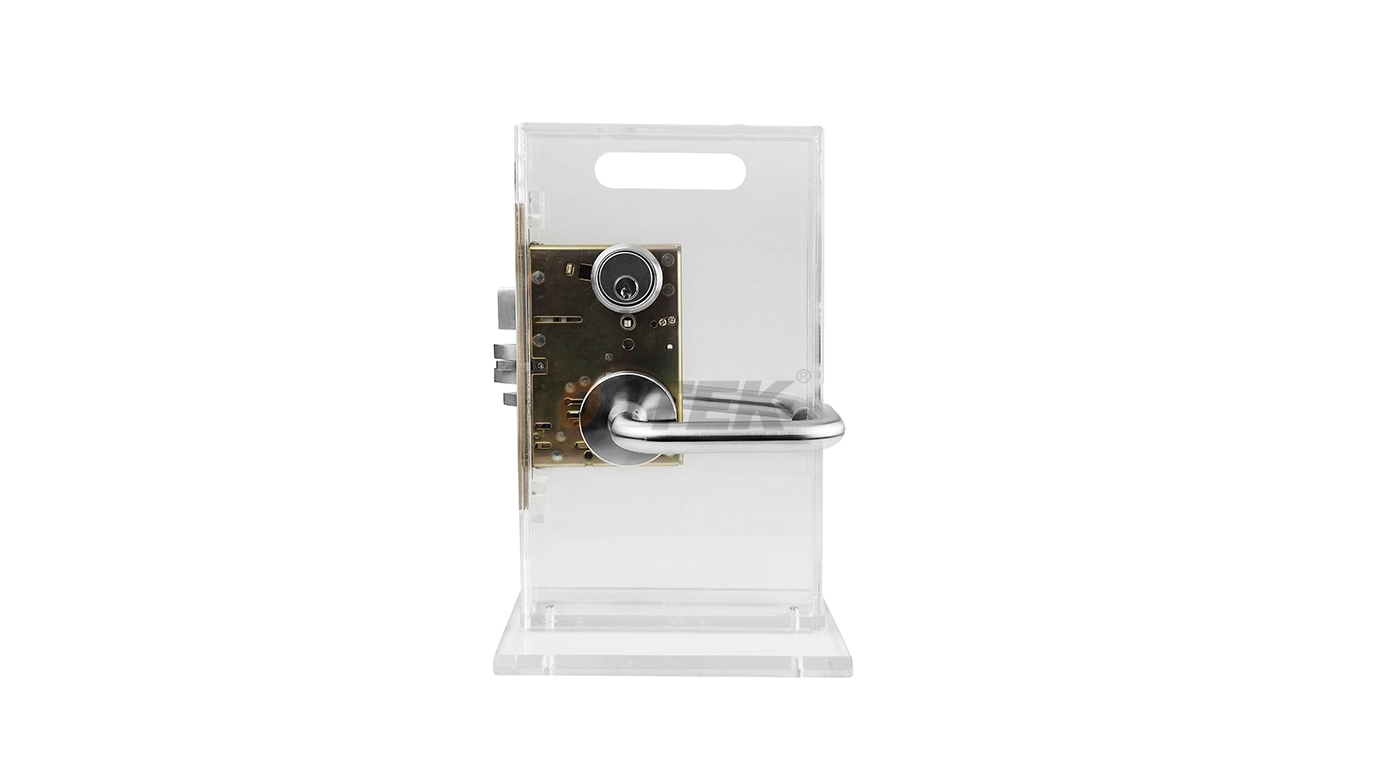Homeowners often find themselves wondering about lock upgrades, especially when moving into older homes or seeking enhanced security. One common question that arises is whether you can convert a cylindrical lock to a mortise lock. The short answer is yes, but the process involves more than simply swapping out hardware.
This conversion requires significant modifications to your door, including cutting a mortise pocket and installing new strike plates. While it's technically possible, the complexity and cost often make it impractical for most homeowners. Understanding the differences between these lock types, the conversion process, and alternative solutions will help you make an informed decision about your home security needs.
Whether you're dealing with an old cylindrical lock that needs replacement or considering an upgrade to mortise hardware for aesthetic reasons, this guide will walk you through everything you need to know.
Cylindrical Locks vs. Mortise Locks
Before diving into the conversion process, it's essential to understand what makes these two lock types different.
What Is a Cylindrical Lock?
A cylindrical lock is the most common type of door lock found in residential properties. These locks feature a cylindrical housing that fits through two holes drilled in the door: a larger hole (typically 2-1/8 inches in diameter) for the lock body and a smaller hole for the latch mechanism.
The key components of a cylindrical lock include:
· Lock cylinder containing the tumbler mechanism
· Knob or lever handles on both sides
· Latch bolt that extends into the door frame
· Strike plate mounted on the door frame
Installation is relatively straightforward since cylindrical locks only require standard-sized holes drilled through the door face and edge.
What Is a Mortise Lock?
A mortise lock represents a more complex and traditionally secure locking mechanism. Instead of fitting through simple drilled holes, these locks require a rectangular pocket (called a mortise) to be cut into the door's edge.
Mortise locks typically include:
· Lock body that fits entirely within the door edge
· Separate cylinder that threads through the door face
· More complex internal mechanisms with multiple locking points
· Heavier-duty construction materials
· Enhanced security features like deadbolts integrated into the same unit
These locks are commonly found in commercial buildings, high-end residential properties, and older homes built before cylindrical locks became standard.
The Conversion Process: What's Involved?
Converting from a cylindrical lock to a mortise lock requires substantial modification to your door. Here's what the process typically involves:
Door Preparation
The most challenging aspect of this conversion is creating the mortise pocket. This rectangular cavity must be precisely cut into the door's edge to accommodate the mortise lock body. The dimensions vary depending on the specific lock manufacturer, but standard mortise pockets are typically:
· 4-1/2 inches long
· 1-1/4 inches wide
· 7/8 inches deep
Hardware Installation
After creating the mortise pocket, you'll need to:
· Install the lock body within the mortise
· Drill new holes for the cylinder (if existing holes don't align)
· Mount the exterior and interior trim pieces
· Install a new strike plate and potentially modify the door frame
· Adjust the lock mechanism for proper operation
Tools and Skills Required
This conversion demands advanced woodworking skills and specialized tools, including:
· Mortise chisels for creating clean, precise cuts
· Router or oscillating multi-tool for rough cutting
· Drill bits for cylinder holes
· Files and sandpaper for fine-tuning the fit
· Measuring tools for accurate placement

Challenges and Considerations
Door Compatibility
Not all doors can accommodate mortise locks. Hollow-core doors, for example, lack sufficient material for creating a proper mortise pocket. Solid wood doors work best, though some solid-core doors may also be suitable depending on their construction.
The door's thickness also matters. Most mortise locks require doors that are at least 1-3/4 inches thick, with some commercial-grade locks needing even thicker doors.
Cost Factors
Converting to a mortise lock involves several cost considerations:
· Professional installation typically ranges from $200 to $500 per door
· Mortise lock hardware costs more than cylindrical locks, often $100 to $300 or more
· Potential door damage during conversion may require repairs or replacement
· Additional costs for strike plate modifications or door frame adjustments
Time and Complexity
Even for experienced DIYers, this conversion can take several hours per door. The precision required for cutting the mortise pocket means mistakes can be costly, potentially ruining the door entirely.
Alternative Solutions
Given the challenges involved in converting cylindrical locks to mortise locks, consider these alternatives:
High-Security Cylindrical Locks
Modern cylindrical lock technology offers impressive security features that rival traditional mortise locks. Look for options with:
· Grade 1 ANSI ratings for maximum security
· Hardened steel components
· Pick-resistant cylinders
· Reinforced strike plates
Electronic and Smart Locks
Many electronic locks use the existing cylindrical lock format while providing enhanced security through:
· Keypad entry systems
· Smartphone connectivity
· Biometric readers
· Remote access control
Door Reinforcement
Rather than changing lock types, consider reinforcing your existing setup with:
· Longer strike plate screws that reach the door frame studs
· Door jamb reinforcement kits
· Security film for glass panels
· Additional deadbolts for double-lock security
When Conversion Makes Sense
Despite the challenges, there are situations where converting to a mortise lock might be worthwhile:
Historical Accuracy
Owners of vintage or historic homes may want mortise locks to maintain architectural authenticity. Many older homes originally had mortise locks, and restoration projects often call for period-appropriate hardware.
Specific Security Requirements
Certain commercial or institutional applications may require mortise locks for insurance or regulatory compliance reasons.
Existing Mortise Preparation
If your door already has a mortise pocket from a previous lock installation, converting becomes much simpler and more cost-effective.
Making the Right Choice for Your Home
When deciding whether to convert your cylindrical lock to a mortise lock, evaluate your specific needs and circumstances. Consider factors like your budget, the condition of your doors, your security requirements, and your long-term plans for the property.
For most homeowners, upgrading to a high-quality cylindrical lock or adding supplementary security measures provides better value than undertaking a complete conversion. However, if you're committed to the aesthetic and security benefits of mortise locks, ensure you work with experienced professionals who can execute the conversion properly.
Remember that any lock is only as strong as its installation and the door it secures. Sometimes, the best security investment involves reinforcing your existing setup rather than completely changing lock types.
commercial Cylinderical lock
Cylinderical lock
Geade two commercial Cylinderical
English
العربية
Français
Русский
Español
Português
Deutsch
italiano
日本語
한국어
Nederlands
Tiếng Việt
ไทย
Polski
Türkçe
አማርኛ
ພາສາລາວ
ភាសាខ្មែរ
Bahasa Melayu
ဗမာစာ
தமிழ்
Filipino
Bahasa Indonesia
magyar
Română
Čeština
Монгол
қазақ
Српски
हिन्दी
فارسی
Kiswahili
Slovenčina
Slovenščina
Norsk
Svenska
українська
Ελληνικά
Suomi
Հայերեն
עברית
Latine
Dansk
اردو
Shqip
বাংলা
Hrvatski
Afrikaans
Gaeilge
Eesti keel
Māori
සිංහල
नेपाली
Oʻzbekcha
latviešu
অসমীয়া
Aymara
Azərbaycan dili
Bamanankan
Euskara
Беларуская мова
भोजपुरी
Bosanski
Български
Català
Cebuano
Corsu
ދިވެހި
डोग्रिड ने दी
Esperanto
Eʋegbe
Frysk
Galego
ქართული
guarani
ગુજરાતી
Kreyòl ayisyen
Hausa
ʻŌlelo Hawaiʻi
Hmoob
íslenska
Igbo
Ilocano
Basa Jawa
ಕನ್ನಡ
Kinyarwanda
गोंगेन हें नांव
Krio we dɛn kɔl Krio
Kurdî
Kurdî
Кыргызча
Lingala
Lietuvių
Oluganda
Lëtzebuergesch
Македонски
मैथिली
Malagasy
മലയാളം
Malti
मराठी
ꯃꯦꯇꯥꯏ (ꯃꯅꯤꯄꯨꯔꯤ) ꯴.
Mizo tawng
Chichewa
ଓଡ଼ିଆ
Afaan Oromoo
پښتو
ਪੰਜਾਬੀ
Runasimi
Gagana Samoa
संस्कृत
Gaelo Albannach
Sepeti
Sesotho
chiShona
سنڌي
Soomaali
Basa Sunda
Wikang Tagalog
Тоҷикӣ
Татарча
తెలుగు
ትግንያውያን
Xitsonga
Türkmençe
संस्कृत
ئۇيغۇرچە
Cymraeg
isiXhosa
ייִדיש
Yorùbá
isiZulu





































